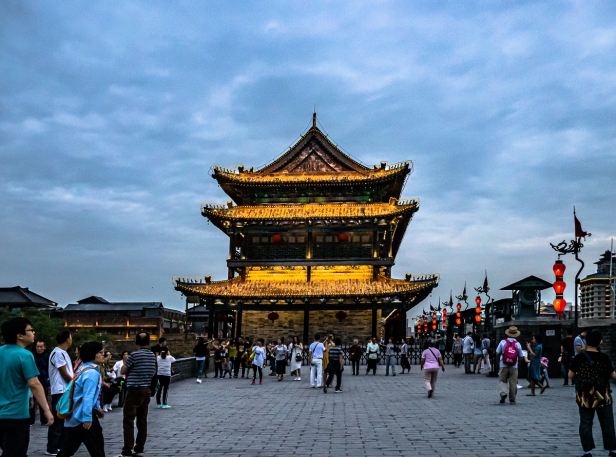
23-25 May 2018.
No way am I being left behind on this adventure! I don’t know if I can do it or not, but I’m sure gonna try.
I’ve always loved cycling. Way back when I lived in Canada’s far northwest I had a 21-speed mountain bike and would ride for hours on largely uninhabited gravel roads or on rough forest trails. Living in Vancouver I’d ride the cycle paths along the waterfront, and Don and I would sometimes take the bikes out to Richmond to ride along the dykes there, or on the trails through Pacific Spirit Regional Park.
Then we did the nomadic thing for over five years, which began with selling or giving away everything we owned, including our bikes.
So here I am in Xi’an, about to go on a 14 kilometre (9 mile) ride with the rest of the group I’m travelling with and I haven’t owned a bike for 7 years, and have barely ridden in that time. I did do a little cycling on the stationary bikes at the gym in preparation for the trip, but I really have no idea if I’m capable of this excursion or not.
Climbing a long steep set of stairs we reach the top of the ancient city walls and head to the bike racks. Peter, our guide, says to wait while he gets helmets. We each choose a bike. We’re just trying them out, but that almost immediately morphs into cycling down the broad expanse of the thoroughfare before us. There’s nothing to stop us. We are gone! Helmets? What helmets? Peter returns with an armful of them and we, all eight of us, are nowhere to be found.
I am loving this! It’s like riding a bike; you don’t ever forget!

It is tricky trying to take photographs while riding, but I even manage that.
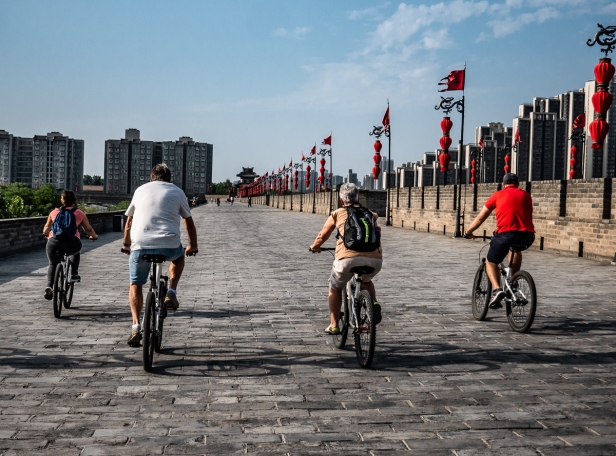
The fortifications of Xi’an were built about 700 years ago during the Ming dynasty, on the foundation of an earlier city wall, which was built during the three-hundred-year Tang dynasty more than a thousand years ago. This ancient defence system, one of the world’s largest, is rectangular, 12 metres high, 18 metres wide at the base, 15 metres wide at the top, and nearly 14 kilometres long. It is a classic example of the rampart architecture of a feudal society, complete with crenelated parapets, watchtowers, and gate towers.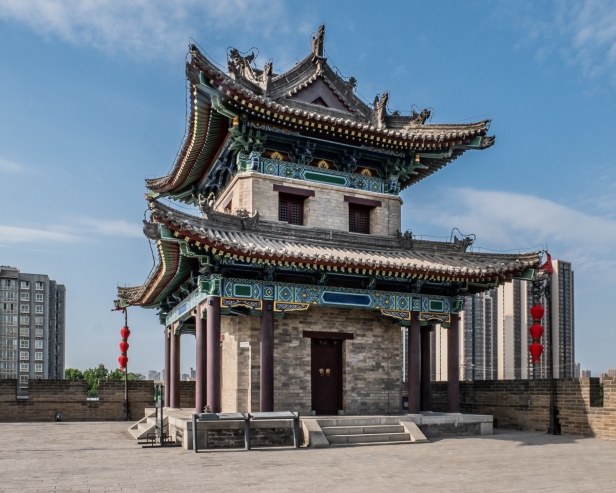

This is a structure built for the ages. Although it has been fully restored there is still a sense of historical timelessness about it, of millennia of purpose and use. It has faced war, and seen the rise and fall of dynasties, and yet it stands, solid and impenetrable. For centuries, both literally and figuratively, it has defined the city of Xi’an.
But we are thinking none of this as we pedal along. It’s an exhilarating ride. The warm air caresses my face, the bike is excellent, the weather is fine, there’s no traffic, or anything to dodge or avoid.
There is only enjoying the ride taking in views of the city

and of the landscaped park and moat surrounding the wall,

and stopping now and then to peer down, getting glimpses into ordinary life in the streets below.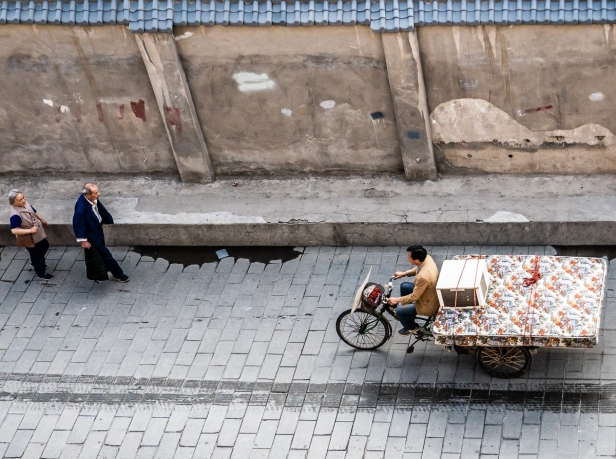

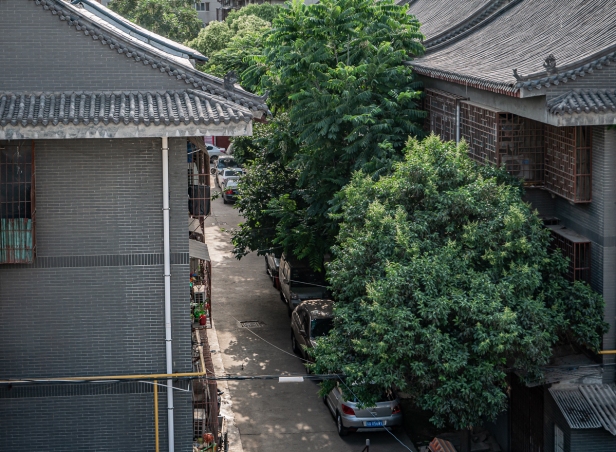
We pass a Buddhist monastery bedecked with prayer flags,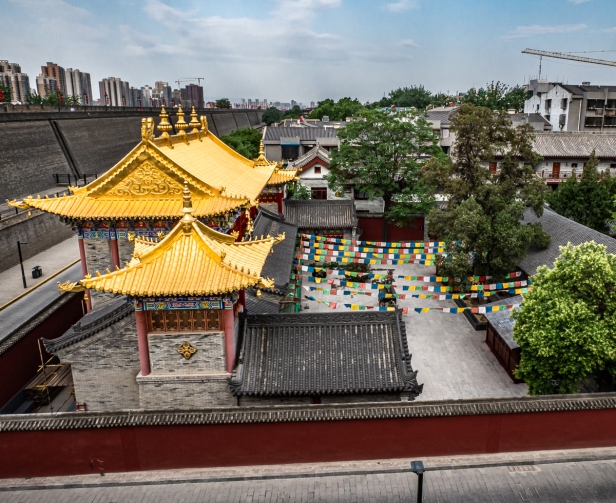

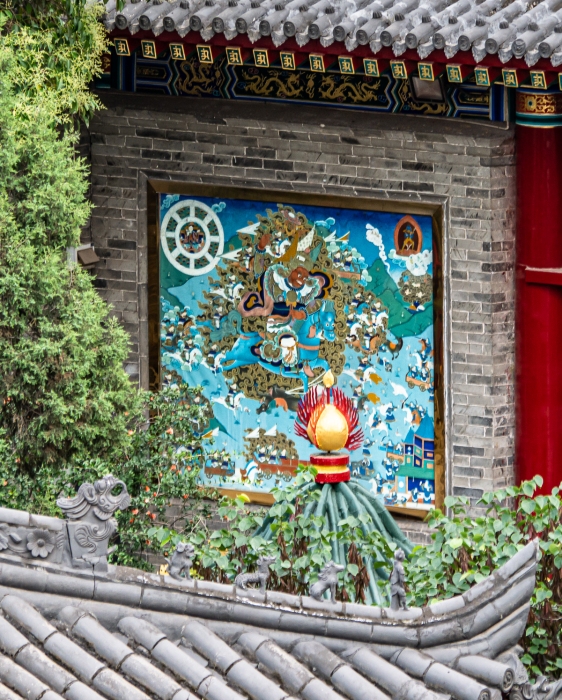
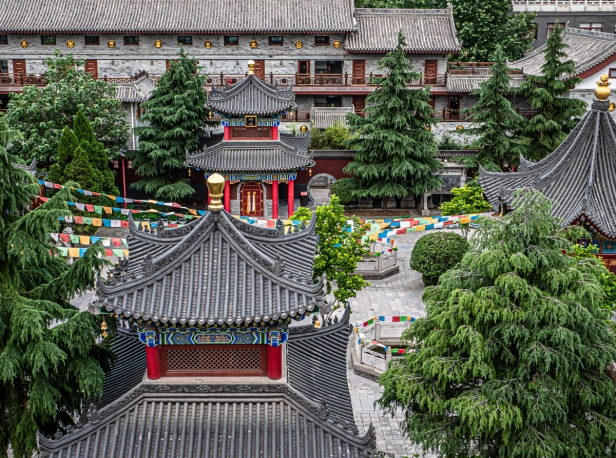
and at the end of the ride we come to the Yongning International Art Museum, an exquisite example of traditional Chinese architecture.


We return the bikes and then we wait.
There are a couple in the group who really want to see the lights from up on top of the wall. From street level we’ve already seen the towers and crenellations lit up on the previous evening,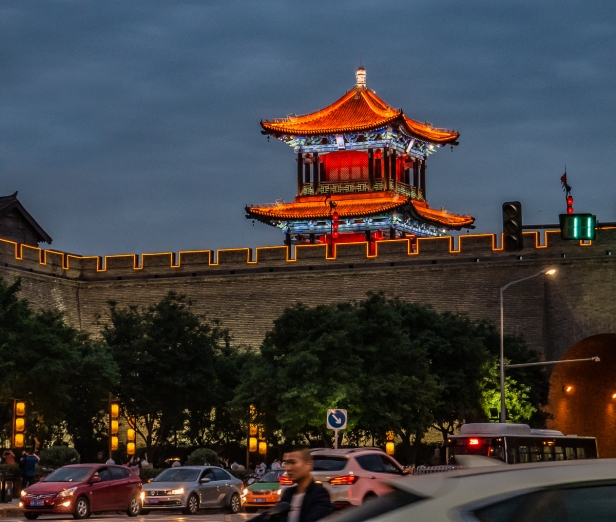
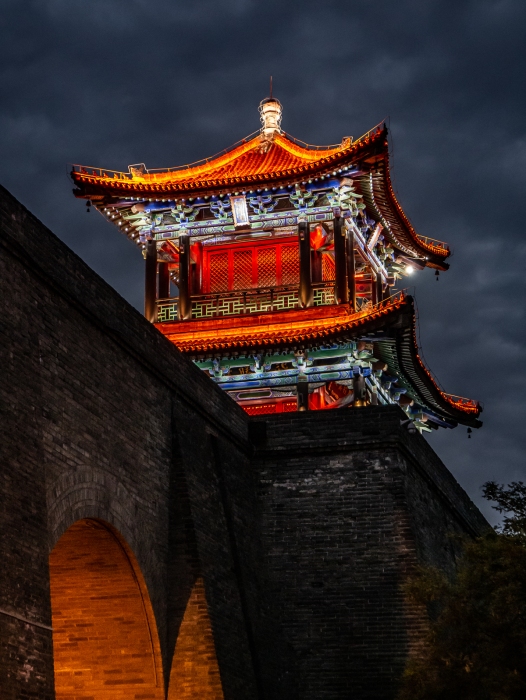
but now’s our chance to see them from the top of the wall. We wait and wait. A couple of us start to grumble a little. Dinner is calling, and sitting around waiting for dark starts to lose its appeal.
And then it happens. The red lanterns start glowing,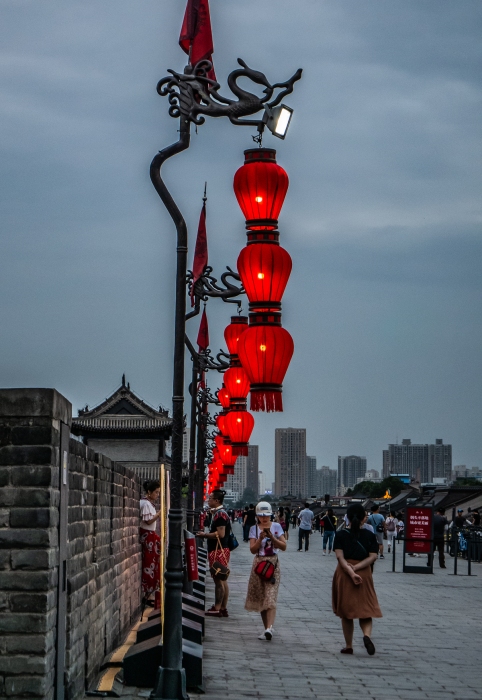
and suddenly the watchtowers and crenellations are shining with a golden radiance against the darkening sky.
It is a magical moment, and definitely worth waiting for. My grumbling dissolves into the fairyland wonder of it all.
The city is lit up, dressed in its evening finery

and we wander down from the wall past the glowing tunnels beneath it,
and past the ancient Bell Tower
on our way to the Muslim Quarter snack street for dinner where I have a meeting with a skewer of very spicy meat.
The Silk Road is the modern name given to the many trade routes across Asia to Europe that began in the 2nd century BCE and continued for nearly 2000 years. If you look at a map of the Silk Road you will see that every route begins, or ends, at Xi’an. The city is 3000 years old. It was the capital for 1000 years, for 13 dynasties, for 73 emperors. The place is marinated in history and is considered the birthplace of Chinese civilisation. There are ageless pagodas, and the “town clocks” of ancient China: a drum tower and a bell tower.
Intermingled with the reminders of the city’s past, modern Xi’an, with a laid-back cosmopolitan atmosphere, is pigeons in the square,
well-tended flower beds,
shiny modern buildings,
a battalion of apartment buildings to house the twelve million people who live in the metropolitan area,
a tangle of Internet wires to keep everyone in the older parts of the city connected,
and a huge square proclaiming KISSKISS and LOVE with the ancient Drum Tower standing guard over it.
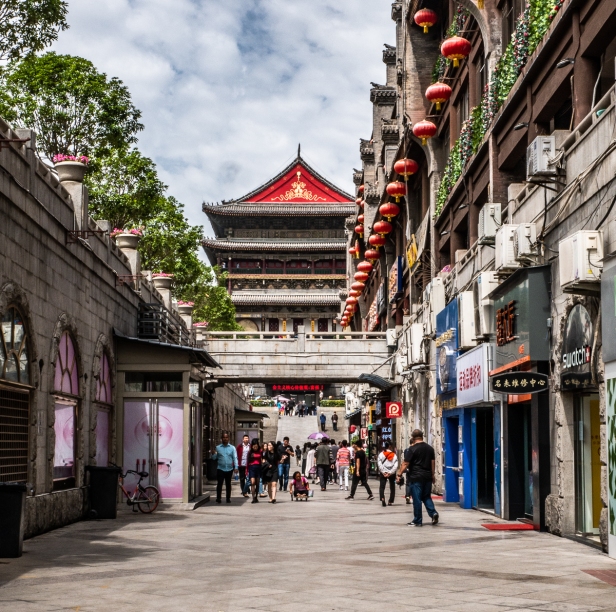
We were in Xi’an so briefly but it turned out to be a highlight that included the incomparable Terracotta Warriors, the exhilarating ride on the city walls, and the renowned Muslim Quarter, home to fifty thousand Hui Muslims, and a direct result of the ancient trade routes.

Next post: Xi’an’s Muslim Quarter
All words and images by Alison Louise Armstrong unless otherwise noted
© Alison Louise Armstrong and Adventures in Wonderland – a pilgrimage of the heart, 2010-2019.

Wonderful photographs and story, Alison. I love all your shots and the one detail of the roof lines with the tiles is so appealing. We were in Xi’an 20 years ago. I need to go back! 🙂
LikeLiked by 1 person
Thanks so much Jane. That building where I showed the detail of the roof lines was quite amazing. I’m so glad I had a little time there to get some shots of it.
Alison
LikeLiked by 1 person
amazing cycling adventure
through the heart of Chinese civilization, Alison.
i’m happy you remembered how to
and took pictures at the same time!
looks magically exotic, especially
when they flipped on the city wall light show.
i had a nice cycle today, but
thanks for bringing me along 🙂
LikeLiked by 1 person
Thanks so much David.
So glad you came along for the ride.
Every time I get on a bike
I remember how much I love it.
This ride was especially
magically exotic!
Alison
LikeLiked by 1 person
Wonderful tour. Thanks so much for taking me along.
LikeLiked by 1 person
Thanks so much Peggy. That bike ride was so much fun – especially in that setting.
Alison
LikeLike
Yes I am getting to like China through your eyes and lens Alison. And the bike ticked all the boxes I think. Thank you Louise
LikeLiked by 1 person
You’re welcome! I’m glad you’re enjoying my view of China. It wasn’t all sweetness and light, but what travel is? For sure it was always pretty fascinating. The bikes were great! We rented bikes in Lima and the one I had was awful, but these ones in Xi’an were really good bikes in good condition. That really helps. Generally China has really good infrastructure for tourists except for language since almost all of the tourists are Chinese.
Alison
LikeLike
What an interesting combination of visuals… I do like the shots of looking down and glimpsing life in the street, and of course the traditional architecture is most fascinating. The exterior of the apartment buildings caught my attention too ~ most unusual, with the decorated facades. The temple shining brightly at night against the dark sky. What a wonderful sight!
Peta
LikeLiked by 1 person
Thanks Peta. I do wish I’d had a little more time in Xi’an, like I did in Beijing, to explore ordinary life on the streets. I could have done but chose to go to an ancient mausoleum instead, and later regretted my choice. Oh well. You can’t win them all. I’m fairly sure those decorated buildings are office buildings. I was quite surprised by them. So beautiful. The apartment buildings are the grey monotonous ones.
The city lights at night, lighting up all the ancient buildings, were quite spectacular – yes, a wonderful sight.
Alison
LikeLiked by 1 person
Great photos as always! Even from a bike!
LikeLiked by 1 person
Thanks so much Tracey. It was a bit wobbly taking them while still riding but I managed to get a couple of shots off. I felt I needed to be keeping up with the others so didn’t want to stop too much.
Alison
LikeLike
WOW!!!!
LikeLiked by 1 person
Thanks, and yes, wow. It was all pretty amazing. The lights especially. And the bike ride – that was so much fun.
Alison
LikeLiked by 1 person
There’s something so rich about the reds in China. Maybe it’s because the color of the stone architecture is so monochrome. It’s somehow both vibrant and calming. Your photos are exquisite. They really capture the different facets of this city.
LikeLiked by 1 person
Thank you so much J.D. I agree about the reds in China. Perhaps it is because they love the colour so much. It is seen everywhere. I sometimes find I have to actually take the saturation back when editing photos.
Alison
LikeLike
Since my early days of blogging, I’ve come across numerous blog posts on Xi’an, and each of them always convinced me to plan a trip one day to this part of China. The sheer number of the terracotta warriors, the ancient city wall and the exquisite pagodas and towers, and the food (you know how much I love spicy food), so many reasons to go! It looks like the weather changed quite dramatically on the day you cycled on the ancient wall — bright, sunny day in the beginning, but very cloudy before sunset.
LikeLiked by 1 person
There is so much to see and do in Xi’an. I’ll write about the Muslim Quarter next post. I also went to another ancient mausoleum – not as mind-blowing as the Terracotta Warriors, but still pretty amazing. And you would LOVE the food!
The weather did change that day (it got gradually more and more cloudy) but I don’t remember being overly conscious of it. It was pretty warm all day.
Alison
LikeLiked by 1 person
This visit with you might have been even better than my own! 🙂 Our bike ride up on the wall is one of my favorite memories of China, but somehow I never really stopped to take photos. Your views from up there, shooting down into the streets or out across the wall and the farther horizons, are fantastic. Like Peta, I was intrigued by the patterned apartment buildings and immediately zoomed in to study them more closely. Your evening scenes are awesome, too!
LikeLiked by 1 person
Thanks so much Lexie. I’m glad you enjoyed a second (vicarious) cycle around the wall. I didn’t have much time to take photos, but everyone stopped from time to time so it was easy enough to keep up with the others.
I think those decorated buildings are office buildings though I’m not sure (in part because of location, and in part because they are so fancy when compared to the other drab apartment buildings). I was blown away by them – so beautiful, and I’ve not seen anything like them elsewhere.
Alison
LikeLiked by 1 person
Exquisite as always! I love the contrasting photos between old and new and also the ones that are taken at night. That tunnel shot is so cool. What a fascinating place Alison. Wow.
LikeLiked by 1 person
Thank you so much Nicole. Xi’an was amazing. A surprise for me since I knew almost nothing about it. I loved the cycle ride, and the ancient buildings everywhere mixed in with the modern development. And for sure the night lights were pretty special.
Alison
LikeLiked by 1 person
How wonderful to see those lanterns turn red. What a wonderful adventure, and good on you for going when you hadn’t cycled in years! Looks like a facinating place.
LikeLiked by 1 person
Thanks Carly. No way was I missing out on that adventure! And, yeah, it was really magical seeing the lights come on up on top of the wall.
Alison
LikeLike
Wonderfully evocative… I never managed to visit Xi’an and you make it sounds such a wonderful destination, I think I should find a way to go back to China and check out all these places I missed. One thing the Chinese have indeed perfected is dazzling an evening sky with imposing and breathtaking illuminations; they never fail to impress!!
Lieve
LikeLiked by 1 person
Thanks so much Lieve. Xi’an is really worth visiting I think. Of course for the Terracotta Warriors which are extraordinary, but also for the Muslim Quarter and all the ancient buildings. I agree, the night lights in every city visited were amazing – we did a three-night cruise on the Yangtze leaving at night from Chongqing and I don’t think I’ll ever forget seeing the city lights from the river as we left. Definitely impressive!
Alison
LikeLiked by 1 person
An extraordinary city, Alison, and your photos capture it so sensitively. I would love to have been there. 🙂 🙂
LikeLiked by 1 person
Thanks so much Jo. It really is an amazing place. My time there was brief but it left a strong impression.
Alison
LikeLiked by 1 person
Biking is the best!! ☺️Wonderful photos of wonderful lights!
LikeLiked by 1 person
Thanks so much Amanda. Yes, biking is the best! I always love it. Maybe it’s time for Don and I to own bikes again! (only in our new place we’ve nowhere to keep them :()
Alison
LikeLike
What an amazing experience. Not only to get back on a bike, but to tour this historic city on a bike would be incredible. Great photos. That wall is so massive, I can’t even imagine the man hours it would have taken to construct!
LikeLiked by 1 person
Thanks so much Carl. It was a really great experience. I’m so glad I went for it. I imagine it took a while, and many many labourers to build that wall. As you say – it is massive!
Alison
LikeLiked by 1 person
Really lovely Alison! I love your posts! xx
LikeLiked by 1 person
Thanks so much Cora. I’m so glad you enjoying my posts!
Alison
LikeLiked by 1 person
Alison – such a glorious bike-side view! It’s a great way to see the larger cities where walking would limit what you can do in a day. I was surprised that there weren’t more cyclists in your photos. Or was that just clever photography? Cheers – Susan
LikeLiked by 1 person
Thanks Susan. It was so wonderful to see the city from on top of the wall. There were actually very few people either walking or cycling the wall – so no trick photography. Many more people came up for sunset and the lighting of the lights.
Alison
LikeLiked by 1 person
Alison, for someone who wasn’t sure she could do this cycle excursion to taking photos while cycling is quite the feat! I especially like your shots of the streets below—very cool perspective. This looks like such an interesting city, and when the nighttime comes, wow! Your photos against the night sky are amazing. I have trouble with evening shots. Did you use a tripod/hold real still?
LikeLiked by 1 person
Thanks so much Caroline. I was bit wobbly taking pics while riding but I wanted shots of the others and needed to keep up with them to get the shots I had in mind – one hand and through the view finder!
Xi’an is a very interesting city – if only for its proximity to the Terracotta Army. But it’s so much more than that. I really enjoyed it.
I have a feature on my camera called “hand held night shot”. It takes 5 shots in rapid succession and merges them. It works quite well. For these shots I honestly can’t remember if I thought to use it or not. Anyway they were all hand held.
Alison
LikeLiked by 1 person
your all picture is so nice
LikeLiked by 2 people
Thank you so much.
Alison
LikeLiked by 1 person
you can to see my wavesite i am new on wavesite
LikeLiked by 1 person
You need to do a little more to it yet. The link says it can’t be found. Good luck with blogging. Once you get the hang of it it’s really fun.
Alison
LikeLiked by 1 person
please visit my site and motivited me https://mdemranhossen147.wordpress.com
LikeLike
Alison good for you to get on a bike after those years. I’m very impressed by the photography while moving. I can’t say I can mange that and I cycle a fair amount! The scenes are stunning and I love the photos when the lights come on at night. Extraordinary.
LikeLiked by 1 person
Thanks so much Sue. I did do some cycling before this trip but honestly not much. But you know what they say about riding a bike 🙂
The photography while moving was pretty challenging trying to balance and frame up the shot but I wanted some of the group riding in front of me. I only managed a couple of shots that way but ended up being pleased with them – good enough anyway!
I’m so glad we stayed up there for the lights to come on. It really was a magical moment.
Alison
LikeLiked by 1 person
There is something about a bicycle that brings out my inner child and an endless sense of freedom. And to cycle through Xi’an would be a dream come true for this adventurer. The buildings, the artwork, the details, the color; your pictures are sheer perfection. That Yongning International Art Museum knocked my socks (okay, my flip-flops) off. And your noise-free, colorful nigh shots are inspiring. The battalion of modern buildings seems almost surreal compared to the older buildings. Loved the closing image.
LikeLiked by 1 person
Thank you so much Lisa for your lovely compliments! Xi’an was a complete surprise for me – the buildings, the night lights, the cycle ride, and yes that art museum! All I knew beforehand was that we would go to see the Terracotta Warriors there, and that in itself was pretty mind-blowing. All the rest was the cherry on the cake that kept on giving.
Alison
LikeLiked by 1 person
Wow, what a ride! (I’m sorry to be so late seeing this!). You reminded me of my mother, who signed up for a bike tour somewhere in Europe even though she hadn’t ridden a bike in decades – decades! She was in her 60’s. She got a bike and practiced before leaving. She had a great time. Impressive Alison – taking photos too! 😉 I love the monastery and museum photos, the night photos, the one at ground level with the pigeons in the foreground. Fabulous. 🙂
LikeLiked by 1 person
Thanks Lynn. Yes, it was a great ride! And your mother sounds amazing!
I was pleased with the night photos (my camera’s not that good in low light) and I couldn’t resist taking the pigeon photo – such a universal scene.
Alison
LikeLike